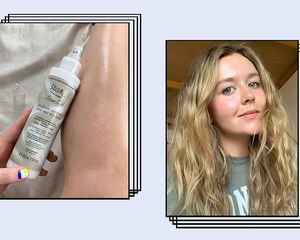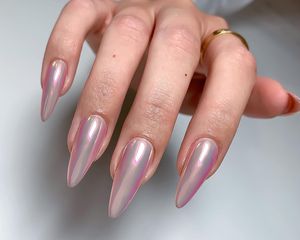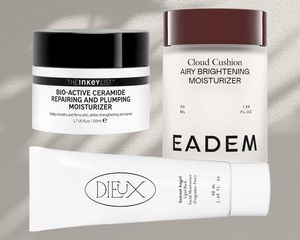:max_bytes(150000):strip_icc()/waxing2main-b7a6e21e81724df383e57f61cbd8055b.jpg)
Stocksy
While the term gets thrown around, many of us might not know what defines a Brazilian wax. And if you have yet to ever have one, you might also be curious about how they became popular and how to prepare for one.
Ahead, we spoke to European Wax Center education manager Gina Petak, board-certified dermatologist Marisa Garshick, MD, and Nad's brand expert and ambassador Natalie Ismiel about everything you need to know about a Brazilian wax, from prep to pain and aftercare.
Meet the Expert
- Marisa Garshick, MD, is a board-certified dermatologist based in New Jersey.
- Gina Petak is the education manager at European Wax Center.
- Natalie Ismiel is Nad's brand expert and ambassador.
How Was the Brazilian Wax Popularized?
Popularized by the now defunct New York salon, The J Sisters, the Brazilian wax came en vogue during the '90s. It was immortalized by the fictional Carrie Bradshaw, who likened the treatment to "walking sex." Janea Padilha of the former famed salon, and the aesthetician who claims to have conceived of the Brazilian wax, counts a bevy of '90s super-starlets—Naomi, Cindy, Tyra, Uma— as clients.
The midtown salon boasted a signed picture of Gwyneth Paltrow posing in a swimming pool that reads, "You changed my life." Can a beauty treatment be that profound? Perhaps. Three decades later, the Brazilian is just as popular with ladies around town, as advanced techniques have made this body grooming treatment less uncomfortable. As Ismiel explains, Brazilians are now even doable at home. "The Nad's wax kit made for Brazilians provides wax that you can use on the most sensitive areas," she says.
What Is a Brazilian Wax?
Unlike a Hollywood wax that leaves you with nary a hair down there, a Brazilian wax lets you keep a small landing strip, either in the shape of a rectangle, small oval, or triangle, on the frontal pubic region. Other than that, "a Brazilian wax is pretty much everything," explains Ismiel. In other words, all hair on the sides of your bikini area and backside is removed. (Sometimes, however, a Brazilian wax and "going completely bare" are synonymous, depending on where you go.) The cost ranges, on average, from $45 to $75.
Hard Wax vs. Strip Wax
Hard wax only adheres to the hair, unlike strip wax, which might take the top layer of skin off along with your hair. "European Wax Center uses an exclusively developed, hard stripless Comfort Wax," says Petak. "This wax is a proprietary blend of beeswax and other European ingredients that ensures you receive the most comfortable waxing experience."
How to Prepare
To prepare for your wax, Petak recommends hair be "at least ¼ inch long (about the size of a sprinkle), so it's a good idea to stop shaving at least five days (and 10-14 days for best results) before your reservation. If you will exfoliate your skin, use a film-free (meaning it rinses off clean, not leaving skin coated in oil) exfoliant 24-48 hours before your wax," she adds.
Garshick says having a tan might make waxing more painful, and to avoid the treatment altogether if you have a sunburn to prevent scarring. Additionally, skip the pool right before your wax, as salt and chlorinated water might be drying or harsh on the skin: "It's best to avoid this just before waxing as the skin can be more prone to irritation or injury if the skin is dry," says Garshick.
"Also, do not get waxed if you take Accutane," she says.
What to Expect During a Brazilian Wax
"Waxing such a sensitive area can be uncomfortable, especially for first-timers," explains Petak. "However, since waxing removes the hair from the root, it makes it grow softer and finer." The more you wax, the less painful the treatments. "A high-quality wax can help make the experience more comfortable." To further minimize pain, consider taking an over-the-counter pain reliever (like ibuprofen or acetaminophen) an hour before the treatment.
"Although it is not necessary, some people find taking an ibuprofen before waxing can help to alleviate the discomfort," says Garshick, who advises against imbibing to numb the pain. "Alcohol is a vasodilator, so it can increase blood flow to the area, making the skin more sensitive and more prone to bruising."
Also, remember to breathe. Deep breaths can be reassuring and calming. So you can anticipate the pain and sync it with your breath. Try to inhale with the wax application and exhale during the removal part of the process. The process takes around 20 minutes, so know the light is at the end of the short tunnel.
Side Effects
Like all types of waxing, Brazilian waxes might lend themselves to irritated skin and discomfort; luckily, you can do a few things to help make life post-waxing more enjoyable.
First, to cut down on ingrown hairs, you should ensure you're not skipping the exfoliation step before waxing. If you still have ingrown hairs even after properly exfoliating, apply a warm compress to the skin and exfoliate gently. Contact your dermatologist if an ingrown hair has become infected (painful, red, and filled with pus). If you want to get ahead of ingrowns, Garshick recommends seeing your doctor about prescription medications that may be helpful after waxing, like cortisone cream or antibacterial lotion.
If you notice small red bumps shortly after you're done waxing, keep the area moisturized, and apply a cortisone cream to reduce redness. Apply clean, sterile cotton over the area if you accidentally burn yourself with hot wax. A dermatologist should see a burn first, regardless of the body part.
DIY Brazilian Wax
If you're in a position where you need to give yourself a wax at home, the first step, as mentioned, is to try and relax, especially since you won't have a technician present to help calm your nerves. "The most important thing is to read the instructions and precautions thoroughly before waxing to minimize pain and irritation," says Ismiel. "Sometimes the pain can be caused by the anxiety you may feel about waxing." Follow her steps below for how to do a Brazilian wax at home.
- Before waxing, find a comfortable position that gives you good visibility. Doing so in front of a mirror is advised.
- Always work on one small area at a time, starting from the outside and working your way into the more sensitive areas.
- If using hard wax, let it cool on your skin for about 30 seconds until it is still soft and pliable but no longer sticky.
- Remove hair by holding the skin taut with one hand and then lift the end of the wax with the fingers of your free hand.
- When you're done, use an oil (like baby oil) to remove any wax residue (water won't do the trick). Most of Nad's products come with Post Calming Wax Oil Wipes to clean up the area afterward.
Can You Wax on Your Period?
If you have a standing appointment and suddenly find your cycle starting, don't panic. "We can wax you if it's that time of the month," says Petak. "Just be aware that the area is more sensitive, and you may experience more discomfort than usual." Make sure to wear a clean tampon so there is no blood present.
How Long Does a Brazilian Wax Last?
According to Ismiel, your wax will last between three to four weeks, but everyone’s rate of regrowth is different, so results will vary.
Aftercare
Dress comfortably for your appointment, and bring a clean pair of underwear to change into. "Loose cotton clothing will cause the least irritation and be more comfortable post-wax," says Garshick. She advises you to shower post-wax in lukewarm water. "It is generally recommended to avoid hot water as the skin is more sensitive post-wax," she adds.
When treating skin post-wax, be careful to use gentle products to reduce the chance of irritation. "Creams or lotions are often the most gentle on the skin post-wax and provide the most hydration, which can be soothing," says Garshick. "You want to avoid any product with an alcohol base as it can lead to a stinging or burning sensation."
Patek recommends EWC's Smooth Me Ingrown Hair Wipes or EWC's Smooth Me Ingrown Serum, which she says is a fan favorite to keep ingrown hairs at bay. When choosing skincare products to use post-wax, Patek advises looking for the following ingredients:
- Diluted Tea Tree Oil: keeps pores and skin clean
- Aloe Vera: anti-inflammatory, helps calm skin
- Chamomile: proven to soothe skin and reduce redness
- Green Tea: proven to nourish skin and provides an anti-inflammatory, calming effect
- Glycerin: helps moisturize skin
To prevent redness or irritation, Garshick advises avoiding harsh ingredients or fragrances if your skin is particularly sensitive.
The Final Takeaway
One of the biggest bonuses of a Brazilian wax treatment is that this grooming style is temporary. Unlike laser hair removal, waxing requires less commitment. If you're not feeling the 'do, you can take solace in the fact that hair grows back, eventually.


